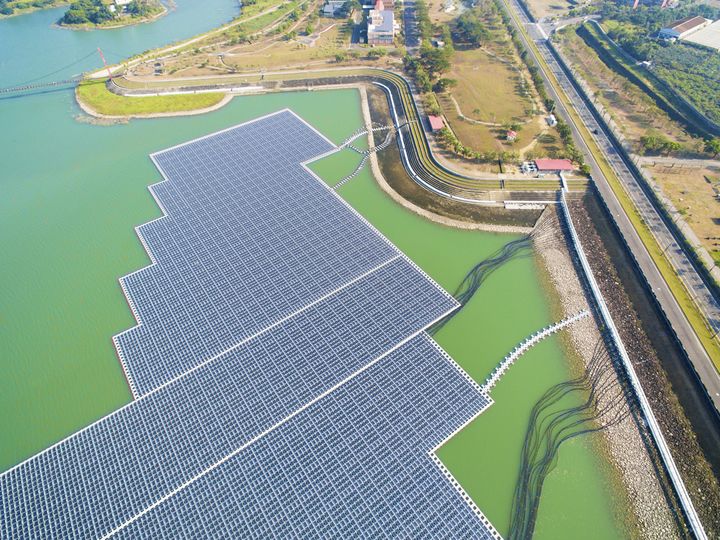A UK-based study (published in June 2024) found that many countries, mainly from Africa, the Caribbean, South America, and Central Asia, could potentially meet between 40% and 70% of their annual electricity demand through FPV.
 Floating Photovoltaics: Solar Power’s New Frontier
Floating Photovoltaics: Solar Power’s New Frontier

Daniel Schroeder, Senior Risk Engineer | Allianz Commercial
In a context of high energy prices and a drive towards low-carbon and renewable energy sources, demand for solar power is rising. Solar is a leading player in the power sector’s transformation, and solar PV alone is expected to meet roughly half of the growth in global electricity demand to 2025.
Floating photovoltaics (FPVs), also known as floatovoltaics, utilizes bodies of water by placing panels on floating structures over dams, old quarries, natural and excavated lakes, as well as coastal and offshore locations. The basic technology used for FPV modules is largely the same as that used for conventional PV installations, with the systems kept in place by anchoring systems.
Advantages of FPVs
A FPV system installed on the reservoir of an already electrically connected structure does not require investment in transmission infrastructure, since the existing infrastructure can be shared. They are also compatible with hydropower, reduce algae growth, water evaporation from the body of water, and dust build up on panels. The cooling effect of water also results in higher PV efficiency of floating photovoltaic systems.
Challenges and Risks of FPVs
Floating PV modules face many of the same challenges as other types of PV installations, but they also face unique risks. Large storms that result in mooring/ anchoring failures are the greatest concern. An event could result in both property damage and business interruption losses, as well as present liability risks. For example, a fire on a floating PV plant on a lake might result in the loss of PV modules and floaters, as well as the pollution of the lake. Installations of FPVs can also cause property damage to artificial lake and fish and loss of business for fishermen with fishing rights.
The Trend
The location of FPV farms on bodies of water makes them an attractive alternative to ground-mounted solar systems, particularly in regions where land is scarce or in high demand. They also keep solar panels cooler, which can heighten their efficiency by up to 15%. The global floating solar market is expected to pass the 6GW threshold by 2031 with a compound annual growth rate expected to rise 15% in the next 10 years.
A UK-based study (published in June 2024) found that many countries, mainly from Africa, the Caribbean, South America, and Central Asia, could potentially meet between 40% and 70% of their annual electricity demand through FPV. Across all countries, the percent of electricity demand that could be met by FPV is 16%, according to the research, which calculated the potential annual electricity generation of floating photovoltaics on nearly 68,000 bodies of water around the world to be 1,302TWh.
Loss Prevention Measures
The long-term reliability of FPV structures is not yet widely documented, as their deployment is relatively new and not yet deployed at scale. However, loss prevention measures can be taken including applying dual-orientation configuration in low latitude tropical regions to mitigate the effects of strong winds, using adequate UV-resistant cable ties or stainless-steel clamps to prevent cable sagging, and reducing moisture by using moisture-hardened material, encapsulants such as TPO (thermoplastic polyolefin), POE (polyolefin elastomer), and ionomer, and glass back sheets on solar panels.
Mitigating mechanical improvements can be realized by increasing panel stiffness or by mounting and placing strings and cells on the neutral axis. To address fatigue, the industry is adopting half-cell modules which have solar cells that are cut in half to reduce the strain on ribbons (the copper conductors in solar panels).
The mooring system should also be robust enough to resist environmental loading and impacts, water level variations, fatigue loading, as well as loads associated with operations and maintenance work. FPV platforms can be anchored either to the bottom of the water body or to the bank of the shore. To ensure the mooring lines remain taut, buoys or auxiliary weights can be added to the mooring system. This can be a challenge for designers as these lines, while being taut, need to be flexible enough to adapt to changes in forces and water levels etc.
Conclusion
The photovoltaic industry continues to evolve, and as time progresses, we are constantly learning and adapting. As we navigate this evolution, it is important to recognize that emerging risks will inevitably arise, necessitating additional mitigation strategies in the future. By staying proactive and continuously improving our understanding and response to these risks, we can support the continued growth and resilience of the PV industry.
Daniel Schroeder is Senior Risk Engineer at Allianz Commercial based in Johannesburg, South Africa. He is registered as a Professional Engineer (Pr. Eng) with the Engineering Council of South Africa (ECSA) and a Member of the South African Institution of Civil Engineering (SAICE). He is focused on the provision of loss control expertise, support and assistance to Allianz and its customers specializing in Large Scale Civil Engineering and Heavy industry projects in Europe, Africa and the Middle East.
The content & opinions in this article are the author’s and do not necessarily represent the views of AltEnergyMag
Comments (0)
This post does not have any comments. Be the first to leave a comment below.
Featured Product

